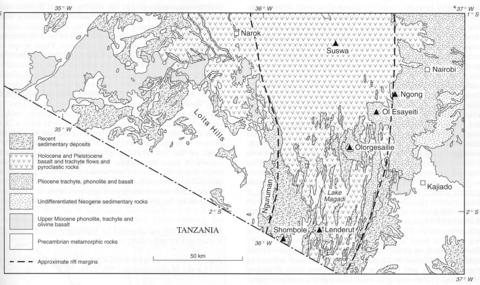stripes
The rocks of the Nairobi area consist of a succession of lavas and pyroclastics of Cainozoic age overlying folded Precambrian schists and gneisses of the Mozambique belt (Saggerson, 1991). The western third of the area is cut by numerous sub-parallel faults that form the eastern flank of the Gregory Rift valley. Many of the volcanic rocks were erupted from fissures adjacent to the rift and flowed eastwards down the rift shoulder but there are also two central volcanoes, Ngong and Ol Esayeiti, in the southwest. The volcanic rocks are divided by Saggerson (1991) into Lower, Middle and Upper Trachyte divisions with extensive phonolites and a little basalt in the Lower division and rhyolites in the Upper. Stratigraphically the products of the Ol Esayeiti and Ngong centres lie between the Lower and Middle divisions and as well as trachyte and phonolite include tephrite and basanite. The oldest rocks are the Kapiti phonolites which are Miocene in age.Their outcrop is not extensive but they have been encountered as the lowest volcanic unit in many boreholes. They contain anorthoclase (up to 76 mm long) and nepheline phenocrysts in a groundmass of aegirine, aenigmatite, katophorite, nepheline, alkali feldspar and analcime. Other phonolites outcrop more extensively the Nairobi phonolite, for instance, underlying much of that town and extending to the eastern edge of the map sheet. This rock contains phenocrysts of sanidine and, characteristically, biotite, in a matrix of katophorite, aenigmatite, aegirine and/or aegirine-augite and nepheline, which is generally replaced by zeolite, sodalite and analcime. There is one unit of phonolitic trachyte in the Lower Trachyte division and three trachyte units all of which contain alkali pyroxene and amphibole and aenigmatite. The Middle Trachyte division includes units of trachytic tuffs in its lower parts many of which are welded, while the trachyte lavas are petrographically similar to those of the Lower division. The Upper Trachyte division includes trachyte, quartz trachyte, rhyolite, comendite and pantellerite. The rhyolitic rocks form a 29 km long zone along the foot of the rift escarpment. Quartz is present in the groundmass and the mafic phases are similar to those of the trachytes but greater variation occurs in the variety of sodic amphibole. The youngest lava in the area crops out in the extreme northwest and is the extremity if a peralkaline trachyte from Longonot volcano (No. 085-00-056). A considerable number of whole rock analyses of the volcanic rocks are given by Saggerson (1991), who discusses their petrogenesis.
SAGGERSON, E.P. 1991. Geology of the Nairobi area. Report, Geological Survey of Kenya, 98: 1-91.

